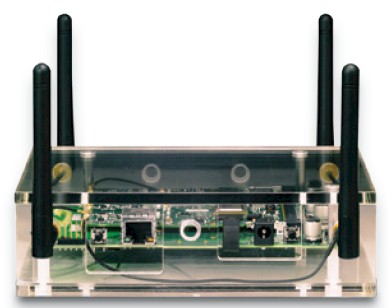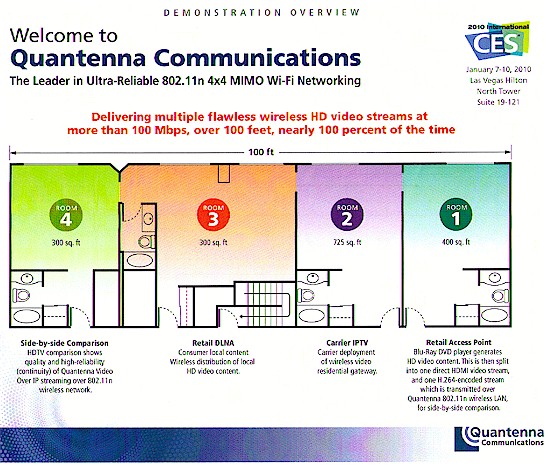Introduction
Update 1/16/2010: Mesh was not used in Quantenna demo.
Last time, I looked at two technologies aimed more at in-room (and perhaps next-room) HD video streaming. This time, I’ll be looking at two companies who have their sights set squarely on enabling whole-home wireless streaming of HD video.
Quantenna
Aside from the announcement of its 600 Mbps 11n video bridge reference design last month, Quantenna was another company totally off my radar screen. The only other announced 4X4 MIMO solution was by Qualcomm back in June. So when I got an invitation to the Quantenna demo at CES, I was intrigued and decided to put it on my list.
Quantenna’s founder, Dr. Behrooz Rezvani, walked me through the demo. He also founded Ikanos Communications, and was key in developing 100 Mbps over-copper VDSL. He explained that the biggest problem in MIMO-based wireless is fighting the effects of fading, which are a primary cause of unreliable performance.
Quantenna says its technology, dubbed "Full-11n", "delivers up to four flawless high-definition (HD) video streams at more than 100 Mbps data rates, over 100 feet, and guarantees this performance nearly 100 percent of the time through near-zero packet error rate (PER) data transfers, regardless of signal impairments and dead zones that are typical in the home".
What is most interesting to me is that this is all done in the 5 GHz band only. Dr. Rezvani explained this is because the 2.4 GHz band is "oversubscribed", i.e. too crowded to ensure reliable transmission. So Quantenna chose to deal with the problem of higher attenuation of 5 GHz signals, rather than wrestle with an overcrowded band.
The reference design bridge, shown below, uses Quantenna’s QHS600 4×4 MIMO chipset. Although a 4×4 MIMO design (four transmit / receive chains) can produce a four-stream 802.11n channel with a 600 Mbps maximum link rate, Quantenna specs only a 300 Mbps maximum link rate, i.e. the equivalent of dual-stream 11n. (NETGEAR’s marketing department apparently hasn’t read the spec sheet and prefers to talk about its upcoming "600 Mbps" bridge.)

Quantenna QHS600x Reference Design Kit
The reason for the 300 Mbps spec is that Quantenna combines four streams into two pairs via "dynamic digital beamforming" to ensure two maximum-rate data streams, "99 percent of the time". In other words, they trade off maximum throughput for 12 to 25 dB of signal gain for increased reliability, which is exactly what’s needed for reliable HD video streaming. Check this video if you’d like Dr. Rezvani to give you a primer on dynamic beamforming.
The demo setup, shown below, had Quantenna reference design bridges set up in four side-by-side hotel rooms. Room 1 had HD source material coming off a Blu-ray player and sent via HDMI cable, IPTV grade wireless and what I’ll call "HDMI-grade" wireless. (This was done to be able to demo to both CE and IPTV customers.)
Quantenna CES Demo setup
Each room had a 1080p display playing flawless video as people moved throughout the demo rooms. Room 4 had side-by-side displays showing Iron Man in HD, so that I could play find-the-cable, allegedly by being able to discern some difference between the HDMI and Quantenna "Full-11n" connections.
But if there were any difference, I couldn’t see it, even when I asked them to close the door between rooms 3 and 4. Finally, Dr. Rezvani grabbed an antenna on one of the reference bridges (the other was not connected to the second screen) to break up and reveal the streamed image.
Overall, I was impressed by this demo for two reasons. First, it was the first (at least that I can recall) multi-room demo I’ve seen involving HD-streamed video. But more importantly, the 5 GHz signal was able to get through three (four if you count the bathroom in Room 3) hotel-grade walls, which I assume are more deadly to RF than normal residential sheetrock walls.
There is one possible catch, however, that could make me less impressed with the demo. As I was fact-checking this story, I found that Mesh Networking is also part of Quantenna’s "Full-11n" bag of tricks. But this was not mentioned at all during the demo. So I’m not sure whether the bridges in each room of the demo were, in fact, configured in mesh mode, which would definitely have helped to ensure a good signal from Room 1 to 4. I emailed Quantenna about this and will update when I hear back from them.
Update 1/16/2010: A Quantenna rep said that mesh was not used in the CES demo.
So at this point, I’m impressed by what I saw of Quantenna’s solution. But I’ve seen impressive demos before, only to have the technology in its end-product form fall short in real world use. Although NETGEAR hasn’t revealed when it will be shipping its Quantenna-based video bridge product, or how much it will cost, I suspect we’ll see it before this middle of this year.
I asked Quantenna whether there technology was used in D-Link’s Rush, which looks similar to NETGEAR’s offering and they said it wasn’t. So that would indicate that D-Link may be going with Qualcomm, who announced its own 4×4 MIMO chipset last June.
Atheros
Atheros announced its three-stream XSPAN with SST3 11n chipset last November. This was apparently too late to keep Apple’s business, which decided to switch to Marvell’s three-stream N chipset for its latest Airport Extreme spin. Apple has probably slipped Marvell three-stream N chipsets into its latest Mac and Powerbooks, too, as it prepares to be one of the first companies to announce three-stream N support across its product line (I’d expect sometime in the coming months).
Ralink has a three-stream chipset that was also announced last year. But I haven’t seen it in any products yet and I didn’t make it to their demo suite, where they were showing it once again.
Atheros’ SST3 uses Low Density Parity Check (LDPC), Maximum Likelihood Demodulation (MLD), Transmit Beamforming and Maximal Ratio Combining as its not-so-secret sauces and can provide some performance benefit even when used with non-SST3 chipsets. But the demo didn’t get into any of that and just focused on showing how fast SST3 can go.
The demo used IxChariot to produce a throughput plot running a continuous stream between a reference AP and client only a few feet apart on a table. The plot showed a nice steady plot of around 280 – 290 Mbps total throughput, from multiple, channel-bonded (40 MHz channel bandwidth) connections using a single radio.
This is lower than the 360 Mbps I saw in Ralink’s demo last year. But I can’t remember the details of either demo clearly enough (and didn’t take good notes) to know whether the setups are apples-to-apples enough for the two numbers to be compared.
While we talked, however, the plot occasionally headed south to the tens of Mbps range. But since the display was set to show only a moving 30 second or so window of time, I couldn’t tell how often these throughput dropouts were happening or how long they were lasting. But if they occur as often and as long as it looked like they do, it wouldn’t bode well for glitch-free HD streaming.
Closing Thoughts
So, there you have it. My tour through four technologies, a few of which I hope to put through their paces in the coming year to see if they live up to their demos. In the meantime, my advice remains as it has been when it comes to using regular 802.11n gear for HD wireless streaming:
- Don’t believe any manufacturer’s claims for bandwidth or coverage when it comes to HD streaming
- It might work if your distances are short enough and content bandwidth requirements stay at or below 20 Mbps.
- Even 100 Mbps Ethernet will work much better than any Ethernet substitute (powerline or MoCA). So drill a hole or run a cable if you want trouble-free HD video streaming.
The fact that two major consumer networking companies are coming out with (or at least have announced—I’m looking at you D-Link!) wireless bridges specifically designed for HD video streaming and the technology behind at least one of them, give me some hope that 2010 may finally be the year of trouble-free (or at least reliable enough) HD video streaming. Or not. Only time, and the real products to test, will tell.

